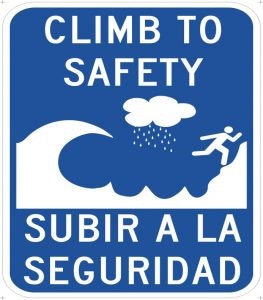Flood Awareness for Communities

Increased snow melting and spring rains can cause flooding.
- If a FLOOD WATCH is issued, it means a flood is possible in the area.
- A FLASH FLOOD WATCH means flash flooding is possible in the area. Be alert to signs of flash flooding and be ready to evacuate quickly.
- A FLOOD WARNING means flooding is already occurring or will occur soon in the area. If a flood warning is issued, listen to local radio and television stations for information. If told to evacuate, do so as soon as possible.
- A FLASH FLOOD WARNING means a flash flood is occurring or will occur very soon. If a flash flood warning is issued, evacuate immediately. There may only be seconds to escape. Act quickly and move to higher ground away from rivers, streams, creeks and storm drains. Do not drive around barricades. If the car stalls in rapidly rising waters, abandon it immediately and climb to higher ground.
Be Prepared
Being prepared when a flood or other natural disaster occurs, can make a difference. In the event of a sudden emergency such as a flood, you may have just minutes to gather your family and important papers and get out of your house, possibly for good. Are you prepared? Where would you go? What would you take with you?
With preparation and practice, you stand the best chance of getting out with what you and your family need. Planning ahead is crucial; this five-step plan can help get you and your family on the road to safety. You can also visit the Kids Corner to create a plan as a family and use the tools there for educating your kids on what to do in an emergency.
Or use this Emergency Plan.- Identify where you can go in the event of an evacuation. Try to have more than one option: the home of a friend or family member in another town, a hotel or a shelter. Keep the phone numbers and addresses of these locations handy.
- Map out your primary route and a backup route in case roads are blocked or impassable. Make sure you have a map of the area available.
- In case your family members are separated before or during the evacuation, identify a specific place to meet and ask an out-of-town friend or family member to act as a contact person.
- Listen to NOAA Weather Radio or local radio or TV stations for evacuation instructions. If advised to evacuate, do so immediately.
A home inventory will help ensure that you have purchased enough insurance to replace your personal possessions. It can also speed the claims process and substantiate losses for income tax purposes. A detailed home inventory is also helpful should you need to apply for disaster aid.
Many programs are available that allow you to organize and list your possessions, as well as add digital photographs of your valuables and upload scanned receipts. Storing your inventory in a secure place online gives you the ability to access it from any computer in the event your own computer is damaged or destroyed.
- Medicines, prescriptions and first aid kit
- Bottled water
- Clothing and bedding (sleeping bags, pillows)
- Flashlight, battery-powered radio and extra batteries
- Special items for infants or elderly or disabled family members
- Computer hard drive or laptop
- Photographs
- Pet food and other items for pets (litter boxes, leashes)
Keep important documents in a safe place that you can access easily. In the event of an evacuation, take the following documents with you:
- Insurance policies
- Prescriptions
- Birth and marriage certificates
- Passports
- Drivers license or personal identification
- Social Security cards
- Recent tax returns
- Employment information
- Wills, deeds and recent tax returns
- Stocks, bonds and other negotiable certificates
- Bank, savings and retirement account numbers
- Home inventory
To find out if you are ready, do a real-time test. Give yourself just 10 minutes to get your family and belongings into the car and on the road to safety. By planning and practicing, you should be able to gather your family members and pets, along with the most important items they will need, calmly and efficiently, with a minimum of stress and confusion.
(Reference: Preparing an Effective Evacuation Plan, October 2012, Insurance Information Institute)
